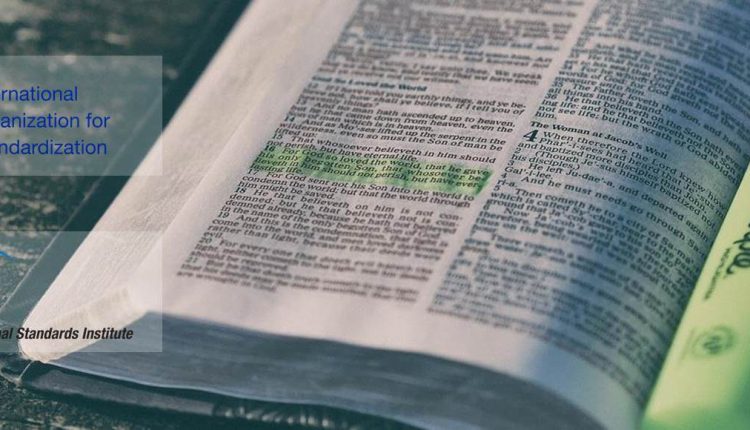ISO, ANSI, CFR: How to Cite Industry Standards and Guidelines

Standards and guidelines are developed to set limits for safety and health issues in specific industries. These can range from those set for child growth to those set for safety precautions surrounding industrial activities or construction. Industries must abide by the standards and guidelines set for them.
For example, the World Health Organization provides guidelines on everything from child nutrition and growth to safety protocols when dealing with immunodeficiency virus. ASIS leads the world in guidelines and education for those in the security industry. The American National Standards Institute (ANSI) provides accreditation to organizations that develop standards for specific industries. This certification attests that procedures meet their essential requirements. The International Organization for Standardization (ISO) develops voluntary international standards and provides common standards among countries.
Citing Sources
To ensure that the standards and guidelines are legitimate, we must be able to use the correct sources and correctly cite those sources. This article helps you understand how to cite standards and guidelines using different referencing styles according to specific industry protocols and style guides. It is important that citing these standards and guidelines be thorough so that the reader can refer to them. It also ensures that the reference is legitimate and recognized in the industry.
Examples from Style Manuals
As mentioned, citing industry standards and guidelines usually depends on the specific style manual being used; however, there are some exceptions. For example, the Institute of Electrical and Electronics Engineers (IEEE) has its own style manual. It refers to the Chicago Manual of Style (CMOS) for basic grammar and punctuation; however, it has its own protocols for citing industry standards.
IEEE
In-text citation: [1] Title of Standard, Standard number, date. For example,
Reference: [1] IEEE Criteria for Class IE Electric Systems, IEEE Standard 308, 1969.
CFR
Another exception is the Code of Federal Regulations (CFR). CFR follows legal style protocols.
In-text citation: (Designation of Uses for the Establishment of Water Quality Standards, 2015)
Reference: Designation of Uses for the Establishment of Water Quality Standards, 40 C.F.R. § 131.10 (2015).
Note that the in-text citation uses the publication name and date; the reference adds the publisher as C.F.R. with the section number and date in parentheses. It does not use the Office of the Federal Register as the publisher.
ASTM
The reference string is as follows:
Base Designation / Edition -Version / Title / Publisher/ Publisher City / Publisher State, Province / Publication Year/ DOI / Publisher Website.
Styles guides such as the American Psychological Association (APA) might have different protocols for citing standards and guides. Some are listed below.
CMOS Style for Citations
Treats published standards as books. If published in a journal, it is treated as a journal article.
For non-scientific books, CMOS uses the notes–bibliography system. Superscript numeral is used in citations while the reference is placed as an endnote or a footnote. At the end of the chapter/book, a complete bibliography is listed. In the sciences (including social science), CMOS uses the author–date system. Citations are entered in parentheses with author and date noted, and the reference section follows the manuscript in alphabetical order by author.
Examples of citations in CMOS style for government publications are below.
In footnotes/endnotes: Firm/Department, Title of Publication as follows:
- Department of Justice, Audit of the Federal Bureau of Prisons Annual Financial Statements Fiscal Year 2014.
Bibliography: Firm/Department. Title of Publication as follows:
Department of Justice. Audit of the Federal Bureau of Prisons Annual Financial Statements Fiscal Year 2014.
APA Format Style
Provides author, date, title, identifier in parentheses, and source as follows:
In-text citation: (Organization That Made the Standard, year). Note the comma after the name in the citation and the title in italics in the reference.
Reference: Organization That Made the Standard. (year). Title of the standard (Standard No. 1234). Retrieved from http://xxxxx.
American Medical Association (AMA) Style Guide
Used in most scientific research manuscripts. In-text citations are in superscript numerals outside of the punctuation. Citations are sequential and references are listed according to that sequence (last name first, initials with no spaces or periods). AMA does not italicize titles and caps only the first word and proper nouns; journal names are abbreviated. For example:
In-text citation: Johnson et al.2….
Reference: 2. Johnson AB, Smith CD, Houser EF. Shifts in alcohol consumption in pre-teens. Am J Clin Nutr. 1975:83(3):600–650.
Use of Acronyms
Many agencies use acronyms in place of the agency name. For example, the Occupational Safety and Health Administration use OSHA, the National Oceanic and Atmosphere Administration uses NOAA, the U.S. Fish and Wildlife Services uses USFWS and so on. It is acceptable in the APA style to use the acronym after the first cite but not in the reference. For example:
First in-text citation: (Occupational Safety and Health Administration [OSHA], 1970)
Subsequent in-text citations: (OSHA, 1970)
Reference: Occupational Safety and Health Administration. (1970). Occupational safety and health standards: Occupational health and environmental control (Standard No. 1910.95). Retrieved from https://www.osha.gov/pls/oshaweb/?p_table=STANDARDS&p_id=9735.
Remember, as long as you have provided complete and accurate information about a reference on industry standards and guidelines, you will meet the requirements of most style guides. Most of what we have presented here will cover most styles used; however, most government publications provide a note in the first few pages stating how publications should be cited. When in doubt, look for that reference as well.









